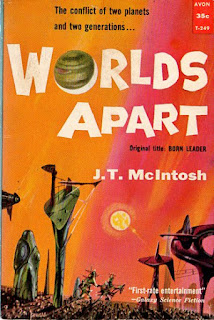Jane Roberts was born 8 May 1929, hence this reposted Ace Double review.
This Ace Double backs a decent, if rather short, John Brunner novel with one of the worst novels I have ever read. Brunner's Listen! The Stars! is about 28,000 words, Jane Roberts's The Rebellers is about 51,000 words.
 |
| (Covers by Jack Gaughan and Ed Emshwiller) |
Dan Cross comes to London to investigate a strange, perhaps ominous, new phenomenon, stardropping. He represents a mysterious organization, but he is pretending to be a new enthusiast. Apparently stardropping is much more popular in England, where it was invented, than in the US. What is it? Well, with some simple electronics it seems one can tune into mysterious signals -- information theory shows they are real signals and not noise. The signals are oddly attractive. Some people get addicted, some people go mad, and there are rumours that some people even disappear.
Cross is able to meet with a local cop, with a young girl addict, with the proprietor of a store selling the equipment, and even with the inventor of the effect, whose son is one of the people who seems to have disappeared. Cross himself tries stardropping, with little effect. But he gets closer and closer to an explanation ... The explanation turns out to be neat enough, with some reasonably well thought out geopolitical implications. The story is just a bit thin, however -- and in a way it seems to end just as the real action should be starting.
Jane Roberts (full name Jane Roberts Butts), published a few short stories, mostly in F&SF, between 1956 and 1964. The Rebellers was her first novel (not counting a "complete novel" in F&SF that was novella length). Her only other novels, according to the ISFDB, were a trilogy about "Oversoul 7", between 1973 and 1984, and a juvenile. She died in 1984, aged only 55. I had never read anything by her. Some of her short fiction seems well regarded, and she was the first woman to attend the Milford Conference of SF writers.
However, she became far more famous in another context. She claimed to have received messages from a supernatural being called Seth, and published a series of books about Seth, perhaps most notably Seth Speaks. These were bestsellers in the 1970s, as I recall, and apparently they remain influential in New Age circles. I will be honest -- at the time, and to this day, I considered these books of a piece with much other spiritualist and New Age stuff -- that is, either completely fraudulent, or possibly a sincere (but silly) result of a mental breakdown. I know others take this seriously, and so be it.
Perhaps my current feelings are partly a result of my reaction to this novel. The Rebellers is set in a grossly overpopulated, plague-ridden, future. Gary Fitch is an artist -- he has lived his life confined in a high-rise in Elmira, New York, part of the Contopolis, making copies of old paintings. This art is deemed important in motivating the workers to help produce the food everyone eats. But Gary is convinced the system is failing, and he dreams of escape.
When rioters attack his building, he takes his chance. After a scary encounter with a government "Doctor" who is ready to put him in suspended animation, he is rescued and taken to the Rebellers -- people who live underground and who are convinced that the system is bad and ought to be changed. But the charismatic Rebeller leader's ideas don't seem just right to Gary either -- and soon he is back in the city, trying to promote a more sensible political organization -- but all seems lost when a newly virulent plague strain breaks out.
Oh, I can't go on. The entire story makes no sense at all. The extrapolation is idiotic. The prose is indifferent. The characters change randomly depending on the needs of the plot. Nothing holds together -- it's economically cockeyed, politically moronic, psychologically silly. And it's boring.
A terrible, terrible, novel.






